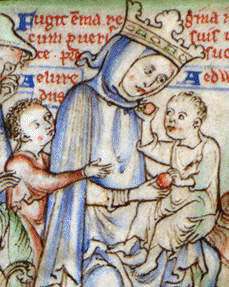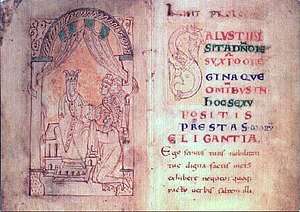Emma van Normandië
Emma van Normandië (?, 985 - Winchester, 6 maart 1052) was een koningin van Engeland.
Emma van Normandië
| ||
| 985-1052 | ||
 | ||
| Koningin-gemaal van Denemarken | ||
| Periode | 1017-1035 | |
| Voorganger | Świętosława (Gunhilda) | |
| Opvolger | Gunhild Svendsdatter | |
| Engelse koningin-moeder | ||
| Periode | 1189-1204 | |
| Opvolger | Eleonora van Aquitanië | |
| Vader | Richard I van Normandië | |
| Moeder | Gunnora van Normandië | |
Levensloop
Emma, ook bekend onder haar Normandische naam Elfvige was een dochter van Richard I van Normandië en van Gunnora van Normandië en een zus van Richard II van Normandië. Nadat in 1000 een Engelse invasie van Normandië mislukt was, werd Emma uitgehuwelijkt aan koning Ethelred II van Engeland. In 1013 moest zij met haar gezin naar Normandië vluchten om veilig te zijn tegen de binnenvallende Vikingen. Na de dood van Sven Gaffelbaard keerden zij terug naar Engeland.
Na de dood van Ethelred in 1016 trouwde zij in 1017 met de nieuwe koning van Engeland en Noorwegen, Canut of Knoet de Grote. Zij werd de moeder van:
- Eduard de Belijder (bij Ethelred)
- Hardeknoet (bij Knoet)
- Gunhilde (bij Knoet), gehuwd met keizer Hendrik III
Toen ook Knoet stierf, ontbrandde de strijd tussen de erfgenamen, die van het eerste huwelijk van Ethelred en die van het eerste en van het tweede bed van Emma. Zij begunstigde de afstammelingen van Knoet boven die van Ethelred II. Maar in 1037 werd Harald, uit het eerste huwelijk van Ethelred, koning en zij moest het eiland verlaten.
Ze kwam in Brugge terecht, waar de graaf haar een luxueuze residentie ter beschikking stelde. Ze kreeg bezoek van haar zoon Hardeknoet, koning van Denemarken en bij die gelegenheid bestelde ze bij een monnik van de Sint-Bertinusabdij van Saint-Omer een lofdicht aan haar adres onder de titel Encomium Emmae reginae, dat bedoeld was als propagandatekst voor de aanvaarding van Knoet op de Engelse troon.
 Emma van Normandië ontvangt de Encomium Emmae. Op de achtergrond staan haar zoons Eduard de Belijder en Hardeknoet. 11e-eeuwse afbeelding |
Ze keerde later naar Engeland terug, hoewel ze in onmin leefde met haar zoon en nieuwe koning Edward de Belijder. Ze bracht haar laatste levensjaren teruggetrokken door in Winchester.
Voorouders
| Voorouders van Emma van Normandië | ||||||||
|---|---|---|---|---|---|---|---|---|
| Overgrootouders | Rollo (860–932) ∞ Poppa van Bayeux (870-na 919) |
? (–) ∞ ? (-) |
? (–) ∞ ? (-) |
? (–) ∞ ? (-) | ||||
| Grootouders | Willem I van Normandië (907–942) ∞ Sprota (-) |
? (–) ∞ ? (-) | ||||||
| Ouders | Richard I van Normandië (933–996) ∞ Gunnora (950-1031) | |||||||
| Emma van Normandië (985–1052) | ||||||||
Externe links
- (en) Emma van Normandië (Foundation for Medieval Genealogy)
- (nl) Het huwelijk van Emma van Normandië met Cnut de Veroveraar Normandië (KU Leuven)
Literatuur
BARLOW, F., ‘Two Notes: Cnut’s Second Pilgrimage and Queen Emma’s Disgrace in 1043’, The English Historical Review, 73 (1958), 649-656.
BOLTON, T., The empire of Cnut the Great: conquest and the consolidation of power in Northern Europe in the early eleventh century (Northern World, 40), Leiden en Boston, 2009.
CAMPBELL, M.W., ‘Emma, reine d’Angleterre, mère dénaturée ou femme vindicative?’, Annales de Normandie, 23 (1973), 97-114.
CAMPBELL, M.W., ‘Queen Emma and Ælfgifu of Northampton: Canute the Great’s Women’, Mediaeval Scandinavia, 4 (1971), 66-79.
CAMPBELL, M.W., ‘The Encomium Emmae Reginae: personal panegyric or political propaganda?’, Annuale Mediaevale, 19 (1979), 27-45.
DAMICO, H., ‘Beowulf's foreign queen and the politics of eleventh-century England’, Renaissance Texts and Studies, 334 (2008), 209-240.
DENNIS, C., ‘Image-Making for the Conquerors of England: Cnut and William I’, BOLTON, B. en MEEK, C. ed., Aspects of Power and Authority in the Middle Ages, Turnhout, 2007, 33-52.
DUGGAN, A.J. ed., Queens and Queenship in Medieval Europe, Woodbridge, 1997.
DUMVILLE, D., ‘The aetheling: a study in Anglo-Saxon constitutional history’, Anglo-Saxon England, 8 (1979), 1-33.
EAMES, E., ‘Mariage et Concubinage legal en Norvège à l’époque des Vikings’, Annales de Normandie, 2 (1952), 196-208.
EARENFIGHT, T., Queenship in Medieval Europe (Queenship and Power), Basingstoke, 2013.
FREEMAN, E.A., The History of the Norman Conquest of England, its causes and its results, 2 dln., Oxford, 1875-76.
HEAD, A., “The gift of elves”, Queen Emma’, Hatcher Review, 3 (1990), 471-479.
HESLOP, T.A., ‘The Production of Deluxe Manuscripts and the Patronage of King Cnut and Queen Emma’, Anglo-Saxon England, 19 (1990): 151-95.
JOHN, E., ‘The Encomium Emmae reginae: a riddle and a solution’, Bulletin of the John Rylands Library, 63 (1980-1981), 58-94.
KEYNES, S., ‘Emma [Ælfgifu] (d. 1052)’, Oxford Dictionary of National Biography (http://www.oxforddnb.com/view/article/8794). Geraadpleegd op 27 maart 2017.
KEYNES, S., ‘Re-Reading King Æthelred the Unready’, D. BATES., J. CRICK. en S. HAMILTON red., Writing Medieval Biography, 750-1250: Essays in Honour of Professor Frank Barlow, Woodbridge, 2006, 77-98.
KEYNES, S., ‘The aethelings in Normandy’, Anglo-Norman Studies, 13 (1990), 173-205.
LAWSON, M.K., ‘Archbishop Wulfstan and the homiletic element in the laws of Æthelred II and Cnut’, A. RUMBLE ed., The Reign of Cnut, King of England, Denmark and Norway, Londen, 1994, 141-164.
LAWSON, M.K., Cnut. The Danes in England in the Early Eleventh Century, Londen, 1993.
LIFSHITZ, F., ‘The Encomium Emmae Reginae a political pamphlet of the eleventh century?’, Haskins Society Journal, 1 (1989), 39-50.
LINDQUIST, O., ‘Encomium Emmae’, Scandia, 33 (1967), 175-181.
O’BRIEN, H, Queen Emma and the Vikings. A History of Power, Love and Greed in Eleventh-Century England, New York en Londen, 2005.
OWEN-CROCKER, G.R., ‘Pomp, Piety, and Keeping the Woman in Her Place: The Dress of Cnut and Emma in BL MS Stowe 944’, Old English Newsletter, 29 (1996), A-27.
SAND, P.S., ‘Engelse Cleopatra slaapt met de vijand’, Historia, 3 (2017), 84-87.
SANKOVITCH, T., Bespreking van P. STAFFORD, Queens, Concubines, and Dowagers: The King’s Wife in the Early Middle Ages, Periodicals Archive Online, 11 (1985), 188-190.
SEARLE, E., ‘Emma the Conqueror’, Studies in Medieval History Presented to R. Allen Brown, C. HARPER-BILL, C.J. HOLDSWORTH en J.L. NELSON eds., Woodbridge, 1989.
SEGERS, E., De Engelse koningin die sliep met de vijand. Het huwelijk van Emma van Normandië met Cnut de Veroveraar in 1017, Onuitgegeven bachelorproef, KU Leuven, departement Geschiedenis, 2017.
SHERIDAN, M., ‘Mothers and Sons: Emma of Normandy’s Role in the English Succession Crisis, 1035-42’, Victims or Viragos?, C. MEEK en C. LAWLESS eds., Dublin, 2005, 39-48.
STAFFORD, P. ‘Women and the Norman Conquest’, Transactions of the Royal Historical Society, 4 (1994), 221-249.
STAFFORD, P., ‘Emma: The Powers of the Queen in the Eleventh Century’, Queens and Queenship in Medieval Europe, A.J. DUGGAN ed., Woodbridge, 1997, 3-26.
STAFFORD, P., ‘Sons and mothers, family politics in the early middle ages’, D. BAKER, Medieval Women (Studies in Church History, 1), Oxford, 1978, 79-100.
STAFFORD, P., ‘The King’s wife in Wessex, 800-1066’, Past and Present, 91 (1981), 3-27.
STAFFORD, P., ‘The laws of Cnut and the history of Anglo-Saxon royal promises’, Anglo-Saxon England, 10 (1982), 173-190.
STAFFORD, P., ‘Writing the biography of eleventh-century queens’, D. BATES., J. CRICK. en S. HAMILTON red., Writing Medieval Biography, 750-1250: Essays in Honour of Professor Frank Barlow, Woodbridge, 2006, 99-109.
STAFFORD, P., Queen Emma & Queen Edith. Queenship and Women’s Power in Eleventh-Century England, Oxford, 1997.
STEVENSON, W., ‘An Alleged Son of Harold Harefoot’, English Historical Review, 28 (1913), 112-117.
STRACHAN, I., Emma, the twice-crowned queen : England in the Viking Age, Londen, 2004.
TYLER, E.M., ‘Fictions of Family: The “Encomium Emmae Reginae” and Virgil’s “Aeneid”, Viator, 36 (2005), 149-79.
TYLER, E.M., ‘Talking about history in eleventh-century England: the Encomium Emmae Reginae and the court of Harthacnut’, Early Medieval Europe, 13 (2005), 359-383.
VAN HOUTS, E.M.C., ‘A Note on Jezebel and Semiramis, Two Latin Norman Poems from the Early Eleventh century’, The Journal of Medieval Latin, 2 (1992), 18-24.
| Zie de categorie Emma of Normandy van Wikimedia Commons voor mediabestanden over dit onderwerp. |